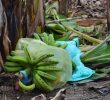DAVAO CITY (davaotoday.com) � The onset of typhoons in Metro Manila, which choked up major roads from surrounding provinces, had temporarily opened up a market for Davao�s vegetables.
Shortly after the tropical storm Ondoy (international name Ketsana) and super typhoon Pepeng (international name Parma) hit the national capital region and other parts of Luzon in September, Davao City had been supplying Metro Manila with 40 metric tons (40,000 kilograms) of vegetables a day because the roads from Baguio City, Manila’s primary vegetable supplier, were choked up by flood.
The Department of Agriculture (DA) in Southern Mindanao said that bringing in additional supply of vegetables from Davao hoped to ease the demand and bring down prices in Metro Manila.
Mindanao vegetables could not normally compete with the market prices in Manila�often dominated by Baguio suppliers�because of the big difference in shipping costs, said Melanie Provido, regional coordinator of the DA high value commercial crops division.
While the transport of goods from Baguio to Manila only takes six to eight hours, transporting vegetables from Davao takes at least two days, using the roll-on, roll-off (roro) facilities in Surigao and Bicol.
Provido said that Davao has been a major vegetable supplier to Cebu, because of its proximity to this Visayan city. Davao also intermittently makes large deliveries to Bicol, Ormoc and Tacloban, areas which are often hit by typhoons.
But she said this was not the first time that vegetables coming from the Davao region augmented the supply in Manila. When typhoon Frank hit Manila last year, Davao also helped ease the demand by sending vegetables there.
She said, however, that 40 tons of vegetables a day, has been the highest demand, so far. �It�s important to flood the market with additional supply to drive down prices,� she said. Carrots, selling only at 50-pesos per kilo in Davao, were already selling at 250-pesos per kilo in Manila at the height of the typhoon. �Even if Davao farmers would sell their carrots at 100 pesos per kilo and Manila traders add another 50 pesos to it, it�s still a big difference,� she said.
Vegetables with long shelf life, like squash and ampalaya (bitter gourd) from vegetable-producing Maragusan town in Compostela Valley province; or in Kapatagan in Digos, Davao del Sur; and other parts of Davao del Norte also found their way to the Manila market.
Provido said it was �good timing� that Ondoy and Pepeng hit towards the end of the year when farmers increased their production to prepare for the high demand during the holiday season. She also credited the region�s increased vegetable supply to the department�s vegetable enhancement program, which expanded the region�s vegetable land by 3,000 hectares. (CJ Kuizon/davaotoday.com)










